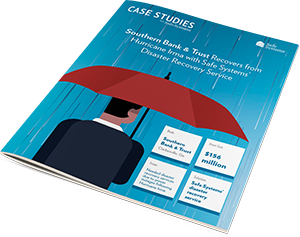Is Your Financial Institution Ready to Weather a Storm? How to Be Prepared for the Upcoming Fall Storm Season

While natural disasters can strike at any time, September and October have historically produced some of the worst storms we have seen. Just last week Hurricane Dorian wreaked havoc on the Bahamas and the Eastern Seaboard of the U.S, disrupting thousands of businesses and organizations, and impacting millions of lives. While hurricane season is top of mind today, tornados, earthquakes, severe thunderstorms, wildfires, etc. all can have a negative impact on area businesses and communities.
As a result, September has been declared National Preparedness Month, designed to encourage and remind everyone to be prepared for disasters or emergencies in their homes, businesses, and communities.
In the spirit of National Preparedness Month, we thought it was important to review the critical steps all banks and credit unions should have in place to ensure they are prepared for a disaster – no matter what time of year it is.
Preparing for Disasters
The potential damage that storms can inflict underscores the importance of Business Continuity Planning (BCP) and Disaster Recovery (DR) plans. In addition, regulators require financial institutions to prepare for disasters and have plans in place that ensure key products and services remain available to customers and members after a crisis. In addition to having an updated and tested BCP and DR plan, there are several additional steps your institution can take to adequately prepare for storms, natural disasters, and any other business outages. These steps include:
- Monitor success of backups and/or replication services to DR site;
- Utilize Uninterruptable Power Supplies (UPS) for short-term outages;
- Preemptively shut down servers and all IT equipment in anticipation of an extended outage;
- Confirm that the server room is locked and secure;
- Verify that all equipment and sensitive documentation is secure;
- Ensure all ATMs are stocked as customers may require access to cash;
- Validate the institution’s Business Continuity Plan through appropriate annual testing;
- Confirm technology infrastructure will work in a disaster through annual DR test;
- Make sure that employees and vendors are aware of the proper communication protocols and actions items outlined in your BCP plan to ensure a successful recovery of an event; and
- Keep the safety and security of employees top of mind. Confirm that key employees have someone to step in should they be unavailable during or after the disaster.
While storms and natural disasters cannot be prevented, proactively knowing what critical functions must be restored first provides confidence to bank executives and staff when responding to a disaster. Developing, implementing, and regularly testing your BCP and DR plans is crucial in today’s banking environment and can make the difference between satisfied customers in the event of a disaster and loss of customer trust when they may need their bank most.



